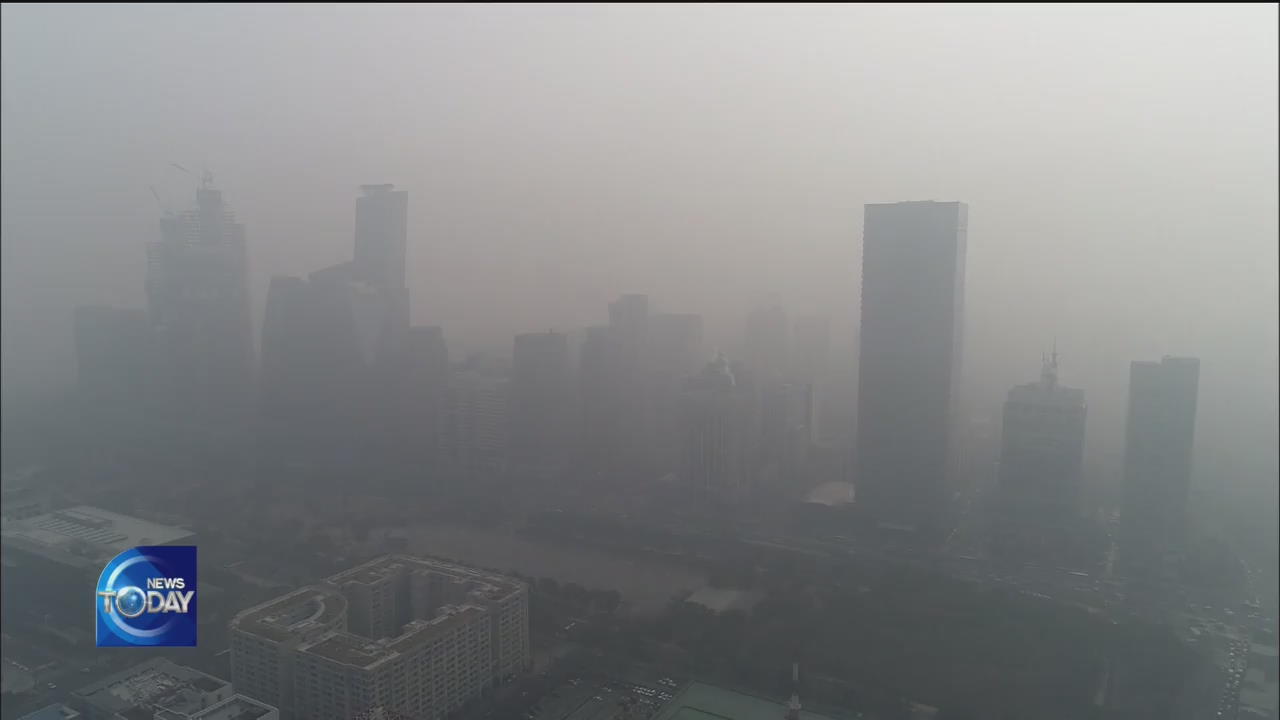FINDINGS ON GUSTY WINTER WINDS IN KOREA
입력 2019.11.13 (15:09)
수정 2019.11.13 (16:45)
읽어주기 기능은 크롬기반의
브라우저에서만 사용하실 수 있습니다.
[Anchor Lead]
A study into winds blowing over the Korean Peninsula, shows that the frequency of gusty winter winds has reduced to about a fifth over the past 3 decades. It's the first time to analyze changes to gale force winds over such an extended period of time. The findings indicate that with reduced wind, high density fine dust has been occurring more frequently.
[Pkg]
In January, the fine dust plague hit Korea from the start of the new year and the dusty air did not clear up for 5 days. With no wind blowing, pollutants in the air remained stagnant and kept accumulating over the Korean Peninsula. The biggest variable to high levels of fine dust is wind. But in recent days, the wind has disappeared from the peninsula. According to a study, over the past 30 years, the occurrence of strong breezes with a speed of over 14 meters per second in Korea was significantly down. Especially in the winter, gusty winds used to blow over 100 times a year. But this number has recently dropped to below 20. When northwesterly winds weaken, the cold weather eases but instead fine dust levels surge due to poor air circulation. The problem is this phenomenon is not a temporary trend.
[Soundbite] KIM BAEK-JO(NIMS) : "The difference in heat between inlands and the ocean has narrowed due to global warming, which in turn has weakened the northwest monsoon. Fewer occurrence of strong winds in the winter is expected to continue."
With global warming accelerating, experts forecast what they call the "prison of fine dust" will repeat each year.
[Soundbite] PROF. YEH SANG-WOOK(HANYANG UNIVERSITY) : "The stability in air circulation is increasing across East Asia, including Korea. This means wind speeds are declining, which can intensify fine dust density in the winter."
Climate change is found to be partially responsible for air pollution remaining the same despite the government's fine dust reduction measures. Efforts must now be made to tackle both global warming and fine dust pollution.
A study into winds blowing over the Korean Peninsula, shows that the frequency of gusty winter winds has reduced to about a fifth over the past 3 decades. It's the first time to analyze changes to gale force winds over such an extended period of time. The findings indicate that with reduced wind, high density fine dust has been occurring more frequently.
[Pkg]
In January, the fine dust plague hit Korea from the start of the new year and the dusty air did not clear up for 5 days. With no wind blowing, pollutants in the air remained stagnant and kept accumulating over the Korean Peninsula. The biggest variable to high levels of fine dust is wind. But in recent days, the wind has disappeared from the peninsula. According to a study, over the past 30 years, the occurrence of strong breezes with a speed of over 14 meters per second in Korea was significantly down. Especially in the winter, gusty winds used to blow over 100 times a year. But this number has recently dropped to below 20. When northwesterly winds weaken, the cold weather eases but instead fine dust levels surge due to poor air circulation. The problem is this phenomenon is not a temporary trend.
[Soundbite] KIM BAEK-JO(NIMS) : "The difference in heat between inlands and the ocean has narrowed due to global warming, which in turn has weakened the northwest monsoon. Fewer occurrence of strong winds in the winter is expected to continue."
With global warming accelerating, experts forecast what they call the "prison of fine dust" will repeat each year.
[Soundbite] PROF. YEH SANG-WOOK(HANYANG UNIVERSITY) : "The stability in air circulation is increasing across East Asia, including Korea. This means wind speeds are declining, which can intensify fine dust density in the winter."
Climate change is found to be partially responsible for air pollution remaining the same despite the government's fine dust reduction measures. Efforts must now be made to tackle both global warming and fine dust pollution.
■ 제보하기
▷ 카카오톡 : 'KBS제보' 검색, 채널 추가
▷ 전화 : 02-781-1234, 4444
▷ 이메일 : kbs1234@kbs.co.kr
▷ 유튜브, 네이버, 카카오에서도 KBS뉴스를 구독해주세요!
- FINDINGS ON GUSTY WINTER WINDS IN KOREA
-
- 입력 2019-11-13 15:02:00
- 수정2019-11-13 16:45:24

[Anchor Lead]
A study into winds blowing over the Korean Peninsula, shows that the frequency of gusty winter winds has reduced to about a fifth over the past 3 decades. It's the first time to analyze changes to gale force winds over such an extended period of time. The findings indicate that with reduced wind, high density fine dust has been occurring more frequently.
[Pkg]
In January, the fine dust plague hit Korea from the start of the new year and the dusty air did not clear up for 5 days. With no wind blowing, pollutants in the air remained stagnant and kept accumulating over the Korean Peninsula. The biggest variable to high levels of fine dust is wind. But in recent days, the wind has disappeared from the peninsula. According to a study, over the past 30 years, the occurrence of strong breezes with a speed of over 14 meters per second in Korea was significantly down. Especially in the winter, gusty winds used to blow over 100 times a year. But this number has recently dropped to below 20. When northwesterly winds weaken, the cold weather eases but instead fine dust levels surge due to poor air circulation. The problem is this phenomenon is not a temporary trend.
[Soundbite] KIM BAEK-JO(NIMS) : "The difference in heat between inlands and the ocean has narrowed due to global warming, which in turn has weakened the northwest monsoon. Fewer occurrence of strong winds in the winter is expected to continue."
With global warming accelerating, experts forecast what they call the "prison of fine dust" will repeat each year.
[Soundbite] PROF. YEH SANG-WOOK(HANYANG UNIVERSITY) : "The stability in air circulation is increasing across East Asia, including Korea. This means wind speeds are declining, which can intensify fine dust density in the winter."
Climate change is found to be partially responsible for air pollution remaining the same despite the government's fine dust reduction measures. Efforts must now be made to tackle both global warming and fine dust pollution.
A study into winds blowing over the Korean Peninsula, shows that the frequency of gusty winter winds has reduced to about a fifth over the past 3 decades. It's the first time to analyze changes to gale force winds over such an extended period of time. The findings indicate that with reduced wind, high density fine dust has been occurring more frequently.
[Pkg]
In January, the fine dust plague hit Korea from the start of the new year and the dusty air did not clear up for 5 days. With no wind blowing, pollutants in the air remained stagnant and kept accumulating over the Korean Peninsula. The biggest variable to high levels of fine dust is wind. But in recent days, the wind has disappeared from the peninsula. According to a study, over the past 30 years, the occurrence of strong breezes with a speed of over 14 meters per second in Korea was significantly down. Especially in the winter, gusty winds used to blow over 100 times a year. But this number has recently dropped to below 20. When northwesterly winds weaken, the cold weather eases but instead fine dust levels surge due to poor air circulation. The problem is this phenomenon is not a temporary trend.
[Soundbite] KIM BAEK-JO(NIMS) : "The difference in heat between inlands and the ocean has narrowed due to global warming, which in turn has weakened the northwest monsoon. Fewer occurrence of strong winds in the winter is expected to continue."
With global warming accelerating, experts forecast what they call the "prison of fine dust" will repeat each year.
[Soundbite] PROF. YEH SANG-WOOK(HANYANG UNIVERSITY) : "The stability in air circulation is increasing across East Asia, including Korea. This means wind speeds are declining, which can intensify fine dust density in the winter."
Climate change is found to be partially responsible for air pollution remaining the same despite the government's fine dust reduction measures. Efforts must now be made to tackle both global warming and fine dust pollution.
이 기사가 좋으셨다면
-
좋아요
0
-
응원해요
0
-
후속 원해요
0















![[단독] 한강버스 운항 두 달 남았는데…일부 공정률 ‘절반 이하’](/data/news/2025/07/01/20250701_LmwC7h.jpg)

이 기사에 대한 의견을 남겨주세요.